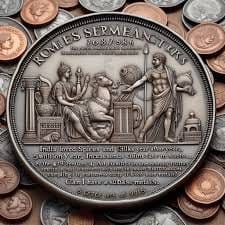
India’s Role in Rome’s Fall: The Gold Drain Mystery
Introduction
The Roman Empire, one of history’s greatest civilizations, had an extensive and sophisticated economy, relying heavily on international trade. Among its most lucrative trade partners was South India, which supplied luxury goods like spices, textiles, and gems. However, this trade came at a significant cost to Rome: a relentless outflow of gold and silver. Some historians argue that this economic imbalance contributed to the empire’s decline. This article explores Rome’s trade with South India, the phenomenon of the “gold drain,” and its possible role in Rome’s fall.
Rome’s Trade with South India
Roman merchants traveled to India via well-established trade routes, using the Red Sea and the monsoon winds to reach the Malabar Coast. Key trade hubs such as Muziris (modern-day Kerala) and Arikamedu (Tamil Nadu) flourished as centers of Indo-Roman commerce. Roman demand for Indian goods was insatiable, with black pepper, fine cotton, silk, pearls, and precious stones being among the most sought-after commodities.
The Periplus of the Erythraean Sea, an ancient Greek maritime guide, provides detailed accounts of Roman trade with India, confirming that ships carried large quantities of gold and silver to pay for these goods. The sheer scale of this trade led to a significant loss of Roman wealth, a phenomenon often referred to as the “gold drain.”
The Gold Drain Phenomenon
Roman historian Pliny the Elder lamented that Rome was spending vast amounts of gold on Eastern luxuries, particularly from India and China. He estimated that the empire lost millions of sesterces annually due to its reliance on foreign imports. Unlike Rome, which primarily exported glassware, wine, and lesser-valued goods, India had little interest in Roman products, further deepening the trade imbalance.
This continuous gold drain meant that precious metals, essential for Rome’s monetary system, were increasingly scarce within the empire. Hoards of Roman coins discovered in South India provide archaeological evidence of this massive outflow, suggesting that wealth was being funneled out of Rome at an alarming rate.
Economic Consequences for Rome
As gold and silver reserves diminished, Rome struggled with financial instability. The lack of precious metals led to coin debasement, where emperors diluted gold and silver content in coins to maintain circulation. This resulted in inflation and loss of public confidence in the currency, weakening Rome’s economy.
Moreover, with financial constraints, Rome found it increasingly difficult to fund its military campaigns and administrative expenses. As the empire expanded, maintaining its vast borders became unsustainable without a strong economic backbone. The weakened economy left Rome vulnerable to external threats, including barbarian invasions, which played a crucial role in its eventual downfall.
Did India Contribute to Rome’s Fall?
The fall of Rome was a complex event with multiple contributing factors, including political corruption, internal strife, and external invasions. However, economic decline was a major underlying issue, and the Indo-Roman trade imbalance played a part in exacerbating Rome’s financial troubles. While South India did not intentionally cause Rome’s downfall, its lucrative trade indirectly contributed to the empire’s economic fragility.
Conclusion
Rome’s extensive trade with South India was both a testament to its economic reach and a contributing factor to its decline. The unbalanced flow of wealth, known as the “gold drain,” weakened Rome’s financial system, making it more vulnerable to crises. While not the sole reason for Rome’s collapse, this economic burden played a significant role in shaping the empire’s fate. The Indo-Roman trade remains one of the most fascinating aspects of ancient globalization, illustrating the far-reaching impacts of economic decisions across civilizations.
By BHARAT GLOBAL TIME


